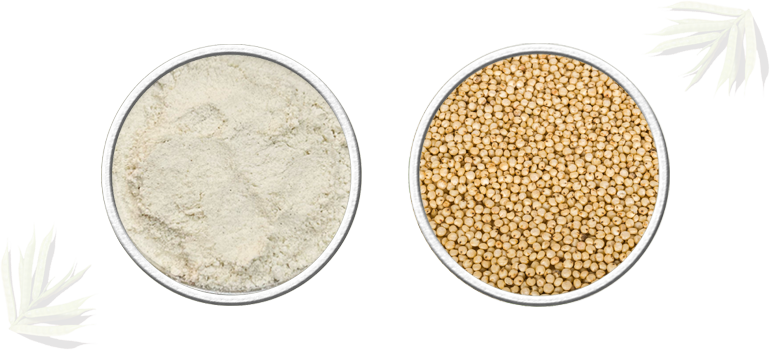Sorghum Flour

Sorghum Flour
Sorghum originated in Africa thousands of years ago, and then spread through the Middle East and Asia via ancient trade routes, travelling to the Arabian Peninsula, India and China along the Silk Road. Today sorghum remains a staple food in India and Africa, and is growing in popularity in America. The whole grain kernel is ground into flour that can be used for cooking and baking.
Sorghum flour is a powerhouse of nutrition and adds a superb flavor to gluten-free baking. It is high in protein, iron, and dietary fiber, making sorghum flour welcome in pantries around the world. Sorghum flour is high in antioxidants, which support cardiac health. In addition, the starch and protein in sorghum take longer than other similar products to digest. This slow digestion is particularly helpful for those with diabetes.
Traditionally this flour has been used as a cereal food to create pancakes, porridges, beer and flatbreads throughout different cultures, such as jowar roti in India. In the United States it is becoming more common to use sorghum flour in baked goods. It can be added or substituted in any recipe that calls for flour like cakes, cookies, breads and muffins. While some gluten free flours, such as rice flour, can add a gritty texture to cookies or bread, sorghum flour has a smoother texture that many people prefer. Due to its very mild taste, sorghum flour is a great choice to incorporate into sweet breads, cookies, or the like.
Using Sorghum in Gluten-Free Recipes
A variety of gluten-free flour mix brands contain sorghum flour blended with other Gluten Free flours, starches and leavening agents. Used alone sorghum produces dry, gritty baked goods- it needs to be used in a Gluten Free flour blend for good results.
Applications
- Confections
- Baked
- Snacks
- Gluten Free Bread Premixes
- Smart FRY Frying Flour
Technical Specification
Specification: Sorghum Flour – Super Fine Grade
Chemical Parameters:
Sr. No.
Parameter
Limits
1
Moisture
12% max
Physical Parameters: Sieve Analysis
Sr. No.
Parameter
Limits
2
Retained on 150 micron
15 % max
3
Gluten
<10 PPM
Microbiological Parameters:
Sr. No.
Parameter
Limits
4
E Coli
<10 per g max
5
Salmonella
Not detected in 25g
Packaging Available :
- 25 Kgs / 50 lbs Multiwall Valve Type Paper Bags.
- 25 Kgs Vacuum Bags.
Storage:
- Storage must be in an area that is clean, dry, cool, well ventilated, away from direct sunlight and from any oily or odorous material & toxic chemicals.
- The area must have pest control program in place to prevent rodent & insect infestation.
| Sr. No. | Parameter | Limits |
| 1 | Moisture | 12% max |
Physical Parameters: Sieve Analysis
Sr. No.
Parameter
Limits
2
Retained on 150 micron
15 % max
3
Gluten
<10 PPM
Microbiological Parameters:
Sr. No.
Parameter
Limits
4
E Coli
<10 per g max
5
Salmonella
Not detected in 25g
Packaging Available :
- 25 Kgs / 50 lbs Multiwall Valve Type Paper Bags.
- 25 Kgs Vacuum Bags.
Storage:
- Storage must be in an area that is clean, dry, cool, well ventilated, away from direct sunlight and from any oily or odorous material & toxic chemicals.
- The area must have pest control program in place to prevent rodent & insect infestation.
| Sr. No. | Parameter | Limits |
| 2 | Retained on 150 micron | 15 % max |
| 3 | Gluten | <10 PPM |
| Sr. No. | Parameter | Limits |
| 4 | E Coli | <10 per g max |
| 5 | Salmonella | Not detected in 25g |
Packaging Available :
- 25 Kgs / 50 lbs Multiwall Valve Type Paper Bags.
- 25 Kgs Vacuum Bags.
Storage:
- Storage must be in an area that is clean, dry, cool, well ventilated, away from direct sunlight and from any oily or odorous material & toxic chemicals.
- The area must have pest control program in place to prevent rodent & insect infestation.


